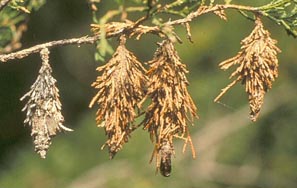Bagworm | |
|---|---|
| June 19, 2008 | |
|
Bagworm, Thyridopteryx ephemeraeformis, hatches around the middle of June in Illinois, but control is most effective if delayed into early July. Bagworms are commonly misidentified by the public. Eastern tent caterpillar, fall webworm, and even plastic grocery bags caught in trees may be identified by clientele as bagworms. Bagworms form silk, spindle-shaped bags up to 1-1/2 inches long. There is only one caterpillar per bag, and it covers the bag with foliage from the host plant. Bagworm overwinters as eggs in the female bag. They hatch in late spring, exiting the bottom of the bag. The tiny caterpillars climb to the top of the tree where they each spin out a silk strand 1 to 3 feet long. This catches in the wind and carries the tiny larva wherever the wind blows. This is called ballooning. The larva then crawls to the top of whatever the silk caught onto and may repeat the process until it lands on a suitable host. The bagworm population continues this process for about 2 weeks. With this form of migration, it is no surprise that bagworms feed on a wide range of hosts. Eventually, the larvae are faced with the choice of feeding on what they land on or starving to death. They are most common on eastern red cedar, spruce, other junipers, arborvitae, white pine, crabapple, and pin oak but are found on many other species of trees and shrubs. They are more common on deciduous hosts in southern Illinois than farther north. Bagworm larvae feed on the edges of broadleaf foliage, sometimes to the midvein. Leaves of needles evergreens are eaten back to the base until nothing remains. Defoliated needled evergreen branches or trees frequently die. Because bagworms start at the top of the tree and work their way downward, it is common to see the top third of evergreens defoliated and dead. Deciduous trees will refoliate, with the damage being primarily aesthetic. Historically, this species has been rare north of Interstate 80 in Illinois; but bagworm has been common in northern Illinois for about the last 6 years. One would assume that a severe winter will eliminate populations north of I-80, but that is yet occur. Although last winter was considered to be severe by most people, from an insect standpoint, it was relatively normal to mild. Temperatures did not go far below zero, and there were no extended periods of subzero weather. Snowfall was heavy, which helped insects overwintering in or on the ground to survive severely cold temperatures. The lack of midwinter thaws that humans missed were beneficial to the insects; they did not have to risk breaking dormancy. Upon leaving its motherís bag, the newly hatched bagworm spins a silk tent and covers it with whatever is available, typically the host vegetation. The bagworms feed through the summer until pupating in late summer. Pupation ranges from mid-August to very early September. Male larvae go through five larval instars; female larvae go through six. For this reason, male bags tend to be smaller than those of the females, and they pupate sooner. As long as the caterpillar is feeding, it places bits of host foliage around the top of the bag. Once it has pupated or died, this practice stops and the top of the bags turn from green to brown. This is useful in scouting because pupated bagworms are not susceptible to insecticide sprays, and killed bagworms do not fall from the tree. Adult male bagworms are about 1/2-inch-long black moths with clear wings. Adult female bagworms are larviform; that is, they emerge from the pupa looking similar to caterpillars. The nonfeeding males fly from bag to bag, mating with the females inside through the bottom of the bag. The nonfeeding females fill most of their bodies with eggs and die in the bag. Each female bag contains 300 to 1,000 eggs. Because bagworm eggs overwinter in the old bags, an effective control measure on shrubs and smaller trees is to handpick the bags from September through May and destroy them. The eggs in bags dropped to the ground will hatch, and the larvae will climb the nearest upright object to balloon. Because the sex ratio in bagworms is about one-to-one, every other bag on average will contain 300 to 1,000 eggs. Handpicking feeding larval bags is effective, but it is less economical due to their higher number. Again, do not just drop the bags on the ground. Collect them and dispose of them far from trees and shrubs, or squeeze them to kill the larva inside before dropping them. Bagworms are historically well-known for not being controlled by organophosphate, carbamate, and organochlorine insecticides during the second half of their larval lifespan. However, Bacillus thuringiensis kurstaki (Dipel, Thuricide), spinosad (Conserve), cyfluthrin (Tempo), permethrin (Astro), and other pyrethroids are effective even on older larvae. Even so, they are more effective on younger larvae, so treatment soon after they stop ballooning is recommended. In addition, controlling younger larvae prevents the damage that would be caused by the larvae through the season. | |
| Author: | Phil Nixon |

